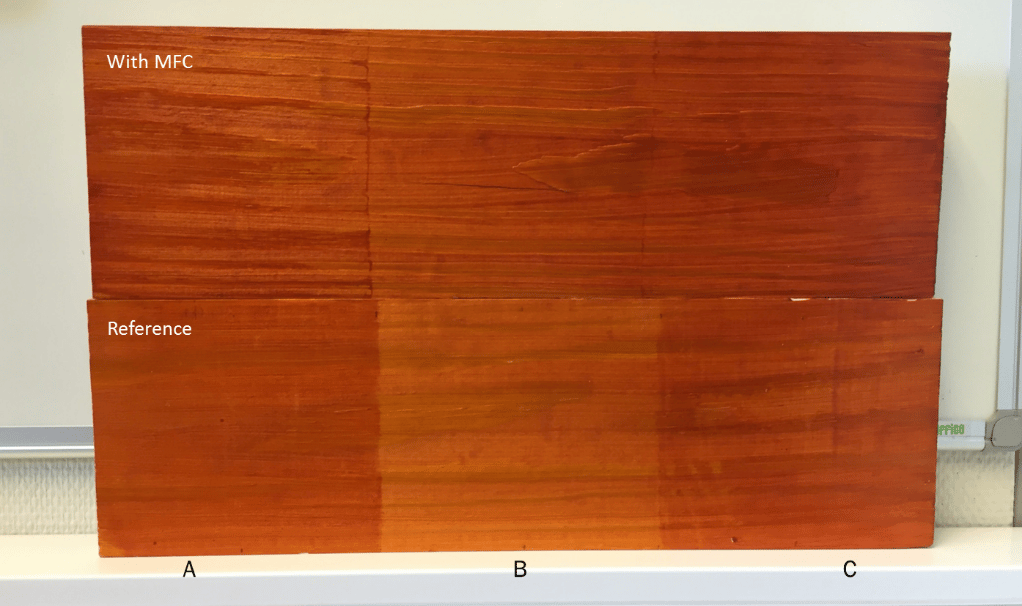
3 great ways to exploit the large surface area of cellulose fibrils
Ole Martin Kristiansen | August 28, 2018
One of the benefits of highly fibrillated cellulose fibrils is its very high surface area. When the fibers are torn down to smaller and smaller fibrils, the surface area consequently increases, which leads to new properties and applications. Learn how its extreme water binding capacity, among other properties, may take your product to a new efficiency level.
Its surface area is considerably higher than the area of many traditional cellulose materials, like cellulose fibers used in paper making or microcrystalline cellulose. Let’s have a look at some examples of applications where this may come in handy.
1. Longer wet edge and open time for coatings
The large surface area can bind a lot of water molecules on the fibers. This leads to a good water holding capacity which is a useful property in different products.
For instance, it can be utilized in wood coatings where the fibrils prolongs the wet edge and open time of the coating. The open time means the period of time when irregularities on the fresh coating layer can be repaired without brush marks. Wet edge time is related to the same properties of the coating and means the time period when a new layer of the coating can be applied without causing lap marks.
These properties can be improved if the outmost layer of the coating remains wet longer. Figure 1 shows how microfibrillated cellulose (MFC) improves the wet edge time, which is related to its water holding capacity. When the time window for applying the second layer, or correcting any marks on the surface increase, the application of the coating becomes more flexible and easier.

Figure: The wood pieces are coated with a reference wood coating and a wood coating containing MFC (Borregaard’s Exilva). The application of the coating is made differently in different parts: A) 2 layers of the coating, 10 min between the application; B) 1 coating layer; C) 2 layers of the coating, 5 min between the application. The wood coating with MFC has smoother appearance between the different application methods, showing that the wet edge time is longer.
2. Composite materials for food packaging
The large surface area means that the cellulose fibrils have a lot of opportunities to interact with surrounding components and materials, also other than water. This is beneficial in composite materials, where a strong adhesion between the reinforcing fibers and surrounding matrix is essential for the strength properties.
In addition, when the fibers are long and thin, the so-called percolation threshold is lower than for macro-sized fibers. Percolation threshold is the lowest mass percentage of fibers that gives a continuous network of fibers and, in that way, a mechanically strong composite. Large surface area makes it possible to prepare stronger composites with a low amount of fibers.
Food packages are an example of composites where the fibrils could be used. In addition to mechanical strength, a MFC film is a good oxygen barrier and suitable for multilayer films. However, its oxygen barrier properties are reduced in humid conditions.
The MFC surface is hydrophilic, meaning that it likes polar compounds like water. This is probably the explanation why MFC loses its oxygen barrier properties in humid conditions: The water molecules get in between the fibers and make the network swollen and looser. The swelling can be reduced by surface modifications which make the fibers more hydrophobic either by physical (adsorption) or chemical modifications. More information on this topic can be found, for instance, in a review by Nair et al. 2014.
3. Carrier in biomedical applications
MFC, with its large surface area, could also be used in biotechnology; as a carrier for enzymes and proteins, carrier in controlled drug release or in scaffolds for cellular culture.
Proteins and enzymes can be used in antibody-based diagnostic, but they are quite sensitive materials, which means they need a carrier to protect them. By trapping the proteins within the porous network, absorbing them or binding covalently on the surface, cellulose fibrils can act as a carrier and increase the stability in operation and storage. To get a good binding between the protein or enzyme and MFC, suitable surface modification is needed.
In similar way, the cellulose fibrils could stabilize drug formulation and, when placed in the human body, release the drug molecules in a controlled way.
A slightly different biomedical application is scaffolds for growing cells which are needed, for instance, to grow new bone tissue after a serious injury. MFC offers mechanical support to the cell growth, and other necessary substances can be adsorbed on the fibers surface.
In general, MFC is a good candidate to be used in human body since cellulose is biocompatible, although not readily degraded by the human body. Lin and Dufresne (2014) have written an interesting review about biomedical applications of MFC and other nanocellulose materials.
Large surface area – a lot of interactions
Above, I have listed examples of how to benefit from the highly fibrillated cellulose fibrils large surface area. Basically, when the material has a large surface area, it interacts more strongly with the surroundings. It means that the material can, for example, adsorb more molecules or have stronger interactions with other substances around it.
This together with the fibrils' good mechanical properties and non-toxicity makes it an attractive material for many purposes.
Editor's note: This post was originally published in May 2016. and written by Anni Karppinen. We've revamped and updated it for accuracy and comprehensiveness.
